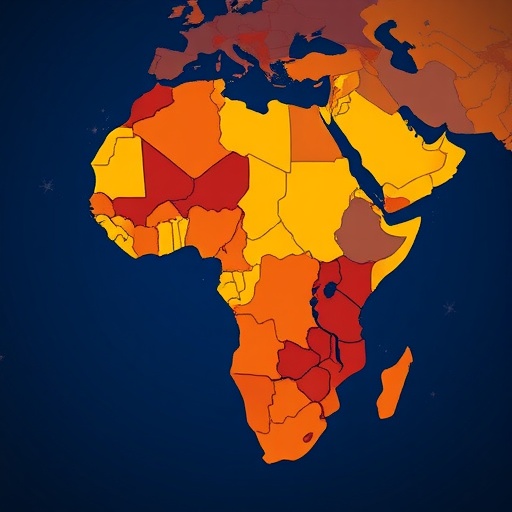Nasopharyngeal carcinoma (NPC), a unique malignancy arising from the epithelial cells of the nasopharynx, has posed persistent challenges in sub-Saharan Africa due to gaps in early diagnosis, treatment access, and survival monitoring. A recent comprehensive study published in the journal BMC Cancer sheds light on the clinicopathological patterns, therapeutic approaches, and patient outcomes for NPC in this geographically and economically diverse region. Conducted at a prominent radiotherapy center and encompassing a decade’s worth of clinical data, the analysis provides critical insights into the complexities of managing NPC in resource-limited environments.
The investigation retrospectively reviewed 83 patients with histopathologically confirmed NPC, treated with curative intent between 2015 and 2025. The cohort’s demographic distribution revealed a relatively young patient population with a mean age of 32.8 years, underpinning the disease’s predilection for younger adults in this setting. A marked male predominance was observed, with a male-to-female ratio exceeding 2:1, hinting at potential sex-linked epidemiological differences in NPC incidence or health-seeking behavior in the sub-Saharan context.
Infectious etiologies, particularly Epstein-Barr virus (EBV) infection, are widely recognized contributors to NPC pathogenesis globally. Intriguingly, only 8.4% of patients in this cohort tested EBV-positive, a markedly lower prevalence compared to endemic regions in East Asia and North Africa. This unexpected finding suggests potential regional variations in viral oncogenesis or laboratory diagnostic limitations that warrant further molecular investigations. Tobacco exposure, another recognized risk factor, was reported in under 10% of patients, indicative of differing environmental or lifestyle influences compared to Western patient populations.
Clinically, the overwhelming majority of patients (94%) presented with an excellent performance status, suggesting that despite the advanced tumor burden, baseline systemic health was well preserved, a critical factor for tolerating aggressive cancer therapies. Nevertheless, disease staging painted a grim picture—approximately two-thirds of patients were diagnosed with late-stage NPC (stages IVA and IVB). This stage distribution reflects ongoing challenges in disease awareness, timely access to medical evaluation, and diagnostic infrastructure within sub-Saharan healthcare systems.
Treatment modalities employed in this cohort centered predominantly on definitive chemo-radiotherapy, recognizing the synergistic benefits of combined modality treatment in NPC management. However, a notable 75.9% received concurrent chemo-radiation without complementary induction or adjuvant chemotherapy phases. This deviation from multimodality protocols raises questions about local guidelines, patient tolerance, or systemic limitations in chemotherapy delivery and supportive care.
Radiation therapy techniques involved standard fractionation schedules, with most patients (78.3%) receiving a prescribed dose of 70 Gy in 35 fractions over seven weeks utilizing advanced linear accelerator (Linac)-based treatment platforms, including intensity-modulated radiation therapy (IMRT). The availability and utilization of such technologies mark significant advancements in treatment capabilities in the region, offering improved tumor targeting while sparing critical normal tissues.
To accommodate organ-at-risk constraints and patient-specific factors, a subset of patients received reduced dosage regimens—doses ranging from 64 to 68 Gy over fewer fractions were administered to balance curative intent with toxicity mitigation. Such dose adjustments underscore the clinical nuances and personalized considerations intrinsic to radiotherapy planning in heterogeneous patient populations.
Treatment-related toxicity profiles were encouraging, with acute adverse events reported in only a quarter of patients and long-term side effects documented in approximately 16%. These relatively low toxicity rates affirm the safety and tolerability of the delivered chemo-radiation protocols, albeit acknowledging the need for continued vigilant monitoring and supportive interventions.
Survival outcomes remain pivotal markers of treatment success and healthcare system efficacy. Disease-free survival (DFS) rates at 1, 3, and 5 years stood at 75%, 45%, and 25%, respectively, indicating a sharp decline over time. Similarly, overall survival (OS) rates of 90%, 65%, and 35% at corresponding time points reflect the persistent challenge of achieving durable remissions in advanced NPC cases.
The study’s conclusions emphasize the critical barriers posed by late-stage presentation, predominantly driven by delayed detection and restricted healthcare accessibility. These findings advocate for intensified public health outreach, screening initiatives, and capacity building in diagnostic services to facilitate earlier diagnosis and intervention.
Despite the promising incorporation of Linac-based radiotherapy and IMRT, the underutilization of chemotherapy suggests missed opportunities for treatment optimization. Strengthening oncology infrastructures to enable comprehensive multimodality therapy, coupled with patient education and adherence support, could markedly enhance outcomes.
Furthermore, the observed epidemiological trends raise intriguing biological questions about NPC pathogenesis in sub-Saharan Africa relative to global patterns. Future research integrating molecular profiling and viral oncogenic studies is warranted to unravel these discrepancies and tailor region-specific management strategies.
Collectively, this landmark study not only benchmarks the current state of NPC care in sub-Saharan Africa but also serves as a clarion call for collaborative efforts to bridge gaps in diagnosis, treatment, and survivorship. With concerted investment in healthcare resources and scientific inquiry, improved prognoses for NPC patients in this region can be realized, aligning outcomes more closely with those seen in higher-resource settings.
As advances in radiotherapy continue to permeate sub-Saharan oncology centers, integrating systematic chemotherapy administration and refining patient selection criteria remain paramount. The nexus of technology, multidisciplinary care, and health system strengthening represents the pathway toward transforming the NPC treatment landscape.
In conclusion, this expansive retrospective analysis contributes invaluable data illuminating the epidemiological, clinical, and therapeutic contours of nasopharyngeal carcinoma in an underrepresented population. It underscores the urgency of early detection initiatives, equitable treatment access, and the necessity for nuanced research addressing regional differences in disease biology and management. Through these efforts, there is hope for enhanced survival and quality of life for patients confronting NPC across sub-Saharan Africa.
Subject of Research: Clinicopathological profiles, management patterns, and survival outcomes of nasopharyngeal carcinoma patients in sub-Saharan Africa.
Article Title: Nasopharyngeal carcinoma in sub-Saharan Africa: clinicopathological profiles, patterns of care, and survival outcomes of patients treated at a leading radiotherapy center.
Article References: Kyei, K.A., Daniels, J., Degefu, T.T. et al. Nasopharyngeal carcinoma in sub-Saharan Africa: clinicopathological profiles, patterns of care, and survival outcomes of patients treated at a leading radiotherapy center. BMC Cancer 25, 1607 (2025). https://doi.org/10.1186/s12885-025-15051-6
Image Credits: Scienmag.com
DOI: https://doi.org/10.1186/s12885-025-15051-6




